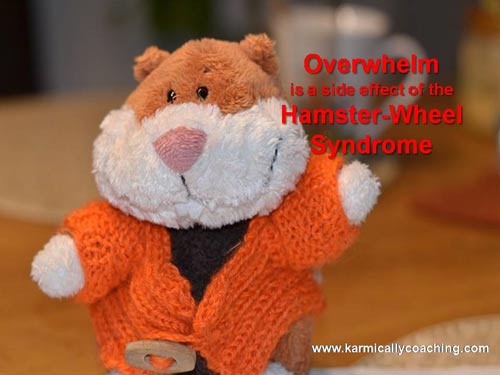
Sometime back I wrote a post about shaking oneself out of a rut suggesting the minor tweaks to get back into our groove and move forward. Those tips definitely work once you know that you are caught in limbo and really want to get out of that awful unproductive place.
In fact, one of the key breakthroughs that happen for my coaching clients is the realization and acceptance of understanding the true nature of their unique rut that burns them out while they are running on their self-created hamster-wheel.
You can’t fix it until you know what is broken, right?
That’s what happened back at one of my favorite Facebook Groups recently when one of our members, a very talented lady with a heart of gold, mother of 2 little children and someone whom I respect immensely, was brave enough to come out in the open and state that she was overwhelmed.
This Group is a very supportive one and many of us immediately reached out to offer empathy, sympathy and advice. She graciously accepted, acknowledged and for the purposes of accountability, we know her action plan and will be there to check in on her. That’s what community spirit is all about.
The fact is, we all feel overwhelmed at some point or the other and even more so when we quite the corporate world and embark on the journey to realize our passion and dreams as solo-preneurs. If you are considering flying solo, then even if you don’t read the rest of this post, make sure you put down Support System in your business checklist.
Overwhelm is a side effect of the Hamster-Wheel Syndrome
It took the Group and the lady some time to nail the cause of overwhelm, like peeling off layers of an onion because the more we wrote in the thread, the more we all learned.

Ultimately, we realized that it was a case of full blown Hamster-Wheel Syndrome which was resulting in inefficiency and ineffectiveness and the feeling of wondering what had been achieved during the course of the day when there were other non-work related areas of life to be attended to. We cannot be so focused on our career or business that we forget that balance in other areas of our life are equally important.
In case you are wondering, Hamster-Wheel is an adjective that means to do or say the same thing over and over or to be repetitious.
4 Steps to get off that Hamster-Wheel without hurting yourself
Accepting that you have a problem is an important step to getting out of a rut and stepping off the proverbial Hamster Wheel.
But the reality is that it isn’t so easy to step off that wheel. Because you have become so used to being on the wheel, that the minute you try to step off it, all those horrible limiting beliefs and fears and other stuff that keeps us awake at night will appear. You will definitely start feeling regret and remorse for all the wasted time while you were on the wheel thinking you were working and may even have the idea that if you spin a little more, then perhaps things will work out. The What If Gremlins have a tendency to crawl out of the woodwork at times like these.
Guess what? You do have what it takes to get off the wheel. You simply need to want to get off badly enough and work on what you can control and influence. These are the exact steps that I shared back in the Group and which do work – ask me, I’ve done the Hamster Wheel Routine to know that one needs that moment of clarity and then the war cry for change.

Step 1 – Acknowledge that you have a habit which can be changed
Habits are patterns of behavior that we engage in because we have done them enough times to make them feel normal and part of our routine. What you need to focus on is breaking the habit and replacing it with a new one.
Be grateful for the experience and learning because sometimes, we don’t learn until we have an experience that tells us to be careful. In Hindi we have a saying that a person who burns their mouth learns to blow on hot milk before drinking it.
Then apply counterfactual thinking, which is the process of constructively assessing how something might have happened by asking the question, “What might I have done?”
This will prompt a new and empowering resolve: “When A happens (or doesn’t happen), I will do B.” and a good reason to stop doing whatever you are doing to stay on the hamster wheel.
Make sure that you visualize or think of a more positive outcome, or what is called an upward counterfactual thought, otherwise you might just end up reinforcing the very pattern of behavior that you are trying to get rid of. Think of ways to improve a situation not find a second best answer to what you can do.
For example, you learn that Periscope is the latest social media fad and lots of entrepreneurs are having great success with it for finding clients and you jump on the bandwagon, sign up for every free training you can find and periscope away like there’s no tomorrow but with zero results because your ideal client doesn’t hang out there.
An upward counterfactual thought would be to consider other possibilities. Perhaps, stop using Periscope but create video content with what you already have or repurpose it to match what your true audience really likes is one way to get out of overwhelm and get productive.
Step 2 – Check if your goals are still SMART and aligned with your objectives
The reason I say this is because you might have started off with some goals that were aligned with your overall objective but your actions are now simply keeping you on the hamster wheel with no real results.
For example, you budget an hour a day on social media to build your visibility and get business leads and join a network of bloggers to get comments and some good old SEO. But after some time, you find you are spending the better part of the day posting and interacting on social media and commenting on blogs with no real client leads in sight or time to create real offline conversations.
It happens to a lot of us. We lose focus of what we intended to do and why we are doing certain actions.
I suggest you stop in your tracks and do a reality check of 3 things.
Are your actions still helping you to achieve your goals or are they now an excuse to do everything but what you are supposed to do to achieve your goals?
When was the last time you checked your progress or noted that things were not working? Now is also a good time to check out your excuses and ask yourself about any secondary benefits for holding onto them. If you find none, let it go.
What should you be doing to achieve your goals?
Make a plan in writing with short term and medium term goals and break down the steps into manageable bytes. Revisit on a regular basis and adjust as the situation changes.
Step 3 – Get out of your comfort zone and embrace change
Quite often we stay on the hamster wheel because we have become accustomed to being on it. In a way it is comfortable even if disastrous for us in the long run because we are able to avoid our responsibilities, decisions and tasks that we know in our heart will help us to move forward in positive motion.
Stepping out of our comfort zone would mean having to face our fears – of failure, success and any other excuse that our fertile imagination may have created to avoid action.
Affirmations, visualizations and tapping will help you to create a positive mindset, but until you get off the chair and do something tangible, not much is going to happen other than spinning some more and feeling exhausted.
A better approach is to do a self-esteem or self-confidence check and ask yourself if you are engaging in negative self-talk or finding excuses to avoid doing what you know you need to do.
In the days when we had dachshunds, I remember the puppies would chew up the shoes Our technique for finding the culprit puppy was to pick them up one at a time and ask, with a bit of puppy talk if they had chewed the shoes. We knew the culprit puppy from the way a puppy would turn their head and eyes away. We lovingly called it ‘no eye contact’ and kept an eye on the puppy for any stomach upsets (chewing shoes is not good for your health).
Perhaps you need to establish eye contact with yourself and do what you know you need to do?
When you do it, be mentally prepared to embrace change. Like I wrote in my post Shake yourself out of your rut, do something different and shake yourself out of your routine. It doesn’t have to be a major change, just a small one that will open you to possibility thinking and new ways of doing things.
Step 4 – Take smart risks
No matter how daunting it may appear to make changes and step out of your comfort zone, be brave and take the risk of doing something that will actually get you off the hamster wheel and onto the road that you were meant to travel.
When I say take risks, I don’t mean doing any dangerous or risky, but well thought out calculated risks that will take you a step further towards your goal. If you feel fear creeping up on you, do a quick mental contrast exercise of where you are right now if you continue doing what you are doing and what could be the possible outcome if you took a chance.
You might find you have more than 1 option in which case, think through both and choose the one that will stretch you just that little bit to get out of your routine and give you a quick result encouraging you to go for bigger changes and actions.
When we step out of our comfort zone and take up the challenge to change our routine, we shake up the status quo which in fact is the only reason we are still on the hamster wheel to start with.
What one action will you take today to get off your private customized Hamster Wheel today?
Additional Resources from The Karmic Ally Coaching Experience:
In addition to my blog posts which can help you get off that Hamster Wheel, here are 2 that I suggest.
Goal Achievement Simplified: When Your Actions Give Results ( my Kindle book) and my free Self Test for Burnout. (Scroll down a little and you’ll see the sign-up form for the self-test and subscription to my newsletter. Don’t worry, I don’t harass people via email and your details are safe with me).





 I adhere to the Certified Coaches Alliance Code of Ethics and Standards. A copy is available on request.
I adhere to the Certified Coaches Alliance Code of Ethics and Standards. A copy is available on request.
 Let's Talk through the Connect Form:
Let's Talk through the Connect Form: